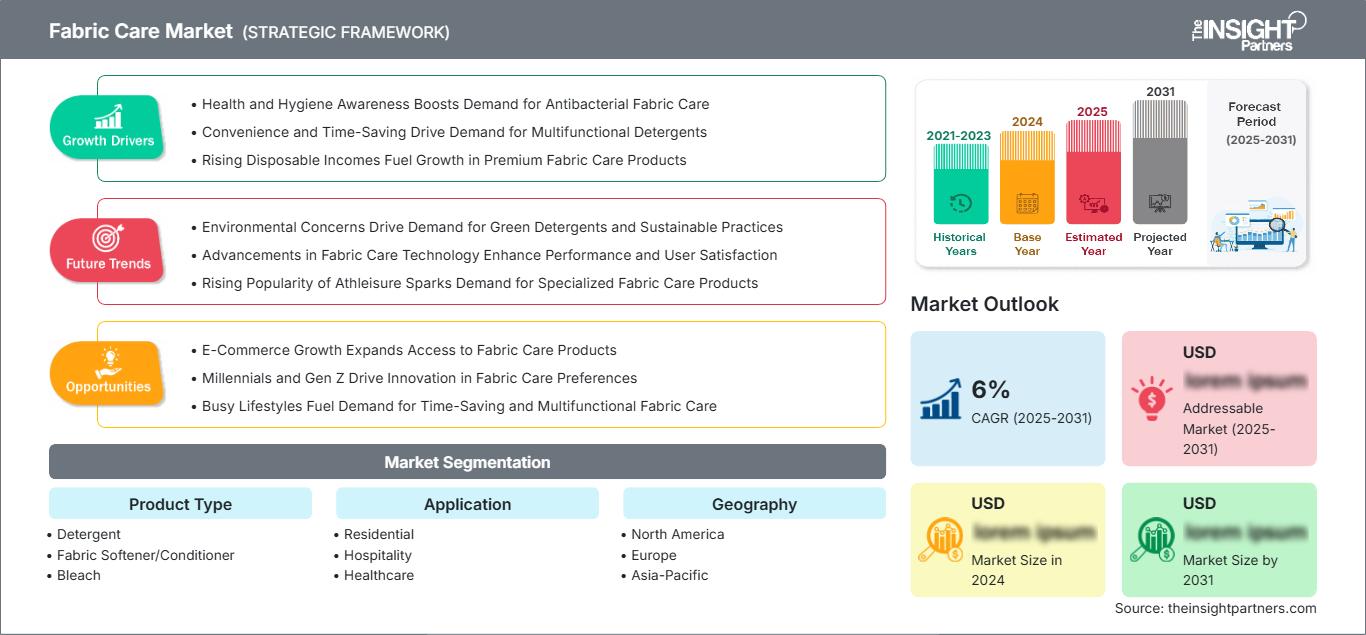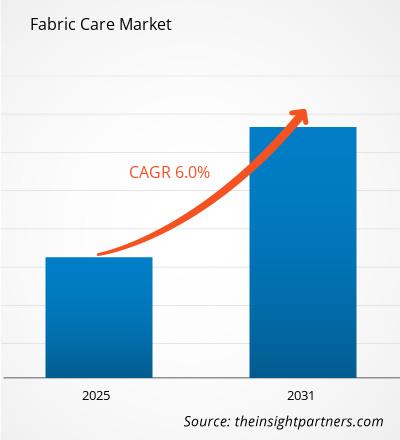页面已更新 :
Jan 2025
预计织物护理市场在 2025 年至 2031 年期间的复合年增长率为 6%,市场规模将从 2024 年的 XX 百万美元扩大到 2031 年的 XX 百万美元。
织物护理市场分析涵盖以下类别:产品类型(洗涤剂、织物柔顺剂/护发素、漂白剂等);应用领域(住宅、酒店、医疗保健、汽车、其他);地域分布(北美、欧洲、亚太地区、中东和非洲、南美和中美)。织物洗涤或织物护理产品主要用于防止衣物因日常洗涤和使用而受损。此外,这些产品还用于汽车和航空等各种行业的洗衣用途。织物护理产品是颇受欢迎的家用清洁产品,可用于清洁各种衣物。
报告目的
The Insight Partners 发布的《织物护理市场》报告旨在描述当前市场格局和未来增长、主要驱动因素、挑战和机遇。这将为各业务利益相关者提供洞见,例如:
- 技术提供商/制造商:了解不断变化的市场动态并掌握潜在的增长机会,从而做出明智的战略决策。
- 投资者:对市场增长率、市场财务预测以及整个价值链中存在的机遇进行全面的趋势分析。
- 监管机构:规范市场政策和监管活动,以最大程度地减少滥用行为,维护投资者的信任和信心,并维护市场的完整性和稳定性。
织物护理市场细分 产品类型
- 洗涤剂
- 织物柔顺剂/护发素
- 漂白剂
应用
- 住宅
- 酒店
- 医疗保健
- 汽车
自定义此报告以满足您的要求
您将免费获得任何报告的定制,包括本报告的部分内容,或国家级分析、Excel 数据包,以及为初创企业和大学提供超值优惠和折扣
织物护理市场: 战略洞察

- 获取本报告的主要市场趋势。这个免费样本将包括数据分析,从市场趋势到估计和预测。
织物护理市场增长动力
- 健康与卫生意识增强推动抗菌织物护理需求:随着健康和卫生意识的增强,尤其是在疫情之后,市场对抗菌和无过敏原织物护理产品的需求也随之增加。消费者需要有效的纺织品清洁解决方案,这推动了产品配方和营销策略的创新。
- 便捷和省时推动多功能洗涤剂需求:这反过来又导致了生活方式的改变,因为大多数人都在寻求更便捷、更省时的织物护理方法。忙碌的消费者选择易于使用的产品,因此需要能够简化洗衣过程的浓缩型多功能洗涤剂。
- 可支配收入的增加推动高端织物护理产品的增长:高端织物护理产品可提供卓越的性能和奢华的体验,这受到消费者可支配收入增加的推动。如今的消费者愿意花钱购买优质洗涤剂、织物柔顺剂以及承诺延长织物寿命并保持其清新的专用产品。
织物护理市场未来趋势
- 环保问题推动对绿色洗涤剂和可持续实践的需求:环保问题和消费者意识的不断增强刺激了对绿色洗涤剂和织物护理产品的需求。随着该类别持续受到关注,领先品牌开始采取行动,开发可生物降解的配方和可持续包装。绿色购物的领导者开始将绿色购物者视为推动市场增长和挑战竞争对手进一步采取可持续实践的一种方式。
- 织物护理技术的进步提高了性能和用户满意度:织物护理技术的进步提高了产品的性能和用户满意度。去污剂和织物柔顺剂等先进成分有助于提高产品的性能,但能够最大限度利用洗涤剂的智能洗衣设备越来越受欢迎,从而推动了市场的增长。
- 运动休闲风潮兴起,刺激专业织物护理产品需求:随着运动休闲和高性能面料的增多,对合适的织物护理产品的需求也随之增长。消费者需要针对特定纺织品的专用洗涤剂和护理产品,这迫使品牌商推出符合时尚和纺织品设计新趋势的定制解决方案。
织物护理市场机遇
- 电商增长拓展了织物护理产品的获取渠道:如今,网上购物触手可及,产品种类繁多,增长速度飞快,扩大了织物护理产品的获取渠道。产品细节以及其他客户的评论会影响通过电商平台做出的购买决策。市场不再局限于传统零售。
- 千禧一代和 Z 世代推动织物护理偏好的创新:年轻消费者,尤其是千禧一代和 Z 世代,会根据其独特的香味、可持续成分和品牌塑造织物护理产品类别。他们的购买力和前沿行为激励品牌不断创新,以满足消费者不断变化的期望。
- 忙碌的生活方式推动对省时多功能织物护理产品的需求:忙碌的生活方式迫使消费者寻找有效的织物护理方法。因此,省时产品或多功能产品的需求旺盛,因为它们符合当今人们的生活方式。
织物护理市场
The Insight Partners 的分析师已详尽阐述了预测期内影响织物护理市场的区域趋势和因素。本节还探讨了北美、欧洲、亚太地区、中东和非洲以及南美和中美洲的织物护理市场细分和地域分布。
织物护理市场报告范围
| 报告属性 | 细节 |
|---|---|
| 市场规模 2024 | US$ XX million |
| 市场规模 2031 | US$ XX Million |
| 全球复合年增长率 (2025 - 2031) | 6% |
| 历史数据 | 2021-2023 |
| 预测期 | 2025-2031 |
| 涵盖的领域 |
By 产品类型
|
| 覆盖地区和国家 | 北美
|
| 市场领导者和主要公司简介 |
|
织物护理市场参与者密度:了解其对业务动态的影响
织物护理市场正在快速增长,这得益于终端用户需求的不断增长,而这些需求的驱动因素包括消费者偏好的不断变化、技术进步以及对产品优势的认知度不断提高。随着需求的增长,企业正在扩展产品线,不断创新以满足消费者需求,并抓住新兴趋势,从而进一步推动市场增长。

- 获取 织物护理市场 主要参与者概述
主要卖点
- 全面覆盖:本报告全面涵盖了对织物护理市场的产品、服务、类型和最终用户的分析,提供了整体格局。
- 专家分析:本报告基于对行业专家和分析师的深入了解而编写。
- 最新信息:由于涵盖了最新信息和数据趋势,本报告确保了业务相关性。
- 定制选项:本报告可以根据特定客户要求进行定制,并恰如其分地适应业务策略。
因此,织物护理市场研究报告可以帮助引领解读和理解行业情景和增长前景的线索。尽管可能存在一些合理的担忧,但本报告的总体优势往往大于劣势。
- 历史分析(2 年)、基准年、预测(7 年)及复合年增长率
- PEST和SWOT分析
- 市场规模、价值/数量 - 全球、区域、国家
- 行业和竞争格局
- Excel 数据集
近期报告
相关报告
客户评价
购买理由
- 明智的决策
- 了解市场动态
- 竞争分析
- 客户洞察
- 市场预测
- 风险规避
- 战略规划
- 投资论证
- 识别新兴市场
- 优化营销策略
- 提升运营效率
- 顺应监管趋势
我们的客户































87-673-9708

ISO 9001:2015



 获取免费样品 - 织物护理市场
获取免费样品 - 织物护理市场